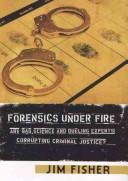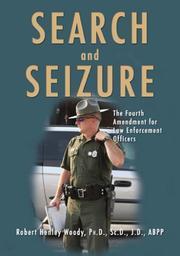| Listing 1 - 10 of 98 | << page >> |
Sort by
|
Book
ISBN: 1617610852 9781617610851 9781617288852 1617288853 9781617288852 Year: 2010 Publisher: [Hauppauge, N.Y.] : Nova Science Publishers,
Abstract | Keywords | Export | Availability | Bookmark
 Loading...
Loading...Choose an application
- Reference Manager
- EndNote
- RefWorks (Direct export to RefWorks)
Book
ISBN: 1633216411 9781633216419 Year: 2014 Publisher: New York, New York : Nova Science Publishers, Inc.,
Abstract | Keywords | Export | Availability | Bookmark
 Loading...
Loading...Choose an application
- Reference Manager
- EndNote
- RefWorks (Direct export to RefWorks)
Before there were emails, instant messaging, and other forms of electronic communication, it was much easier for the courts to determine if a government investigation constituted a Fourth Amendment ""search."" If the police intruded on your person, house, papers, or effects-tangible property interests listed in the text of the Fourth Amendment-that act was considered a search, which had to be ""reasonable"" under the circumstances. However, with the advent of intangible forms of communication, like the telephone or the Internet, it became much more difficult for judges to determine when certai
Book
ISBN: 9786613926258 0739129783 1283613808 9780739129784 9780739129777 0739129775 6613926256 9781283613804 Year: 2009 Publisher: Lanham, Maryland ; Plymouth, England : Lexington Books,
Abstract | Keywords | Export | Availability | Bookmark
 Loading...
Loading...Choose an application
- Reference Manager
- EndNote
- RefWorks (Direct export to RefWorks)
This book explains the different approaches to interpreting the Fourth Amendment that the Supreme Court has used throughout American history, concentrating on the changes in interpretation since the Court applied the exclusionary rule to the states in 1961. It examines the evolution of the warrant rule and the exceptions to it, the reasonableness approach, the special needs approach, individual and society expectations of privacy, and the role of the exclusionary rule.
Multi
ISBN: 9780128096093 0128096098 0128093609 9780128093603 Year: 2018 Publisher: London, England : Academic Press,
Abstract | Keywords | Export | Availability | Bookmark
 Loading...
Loading...Choose an application
- Reference Manager
- EndNote
- RefWorks (Direct export to RefWorks)
Forensic Ecogenomics: The Application of Microbial Ecology Analyses in Forensic Contexts provides intelligence on important topics, including environmental sample provenance, how to indicate the body decomposition timeline to support postmortem interval (PMI) and postmortem submersion interval (PMSI) estimates, and how to enhance identification of clandestine and transit grave locations. A diverse group of international experts have come together to present a clear perspective of forensic ecogenomics that encapsulates cutting-edge, topical and relevant cross-disciplinary approaches vital to the field. Considers the effects of decomposition on bacterial, fungal and mesofaunal populations in pristine ecosystemsExamines the role of the microbiome, necrobiome and thanatomicrobiome in postmortem interval estimationsFocuses on the application of different analytical techniques across forensics to enhance/expand the crime scene investigation toolkitWritten by a wide range of international experts in their respective fields.
Book
ISBN: 1351731556 1351731548 9781315184579 1315184575 9781138738737 9781351731546 Year: 2018 Publisher: London, [England] ; New York, New York : Routledge,
Abstract | Keywords | Export | Availability | Bookmark
 Loading...
Loading...Choose an application
- Reference Manager
- EndNote
- RefWorks (Direct export to RefWorks)
Searches and seizures. --- Electronic surveillance. --- Evidence, Criminal.
Book
ISBN: 0128013583 0128012455 9780128013588 9780128012451 9780128012451 Year: 2016 Publisher: London : Elsevier,
Abstract | Keywords | Export | Availability | Bookmark
 Loading...
Loading...Choose an application
- Reference Manager
- EndNote
- RefWorks (Direct export to RefWorks)
Crime scene searches. --- Crime scene investigations --- Searches of crime scenes --- Criminal investigation

ISBN: 1281397229 9786611397227 0813544246 9780813544243 0813542715 9780813542713 9781281397225 Year: 2008 Publisher: New Brunswick, N.J. : Rutgers University Press,
Abstract | Keywords | Export | Availability | Bookmark
 Loading...
Loading...Choose an application
- Reference Manager
- EndNote
- RefWorks (Direct export to RefWorks)
Television shows like CSI, Forensic Files, and The New Detectives make it look so easy. A crime-scene photographer snaps photographs, a fingerprint technician examines a gun, uniformed officers seal off a house while detectives gather hair and blood samples, placing them carefully into separate evidence containers. In a crime laboratory, a suspect's hands are meticulously examined for gunshot residue. An autopsy is performed in order to determine range and angle of the gunshot and time-of-death evidence. Dozens of tests and analyses are performed and cross-referenced. A conviction is made. Another crime is solved. The credits roll. The American public has become captivated by success stories like this one with their satisfyingly definitive conclusions, all made possible because of the wonders of forensic science. Unfortunately, however, popular television dramas do not represent the way most homicide cases in the United States are actually handled. Crime scenes are not always protected from contamination; physical evidence is often packaged improperly, lost, or left unaccounted for; forensic experts are not always consulted; and mistakes and omissions on the autopsy table frequently cut investigations short or send detectives down the wrong investigative path. In Forensics Under Fire, Jim Fisher makes a compelling case that these and other problems in the practice of forensic science allow offenders to escape justice and can also lead to the imprisonment of innocent people. Bringing together examples from a host of high-profile criminal cases and familiar figures, such as the JonBenet Ramsey case and Dr. Henry Lee who presented physical evidence in the O. J. Simpson trial, along with many lesser known but fascinating stories, Fisher presents daunting evidence that forensic science has a long way to go before it lives up to its potential and the public's expectations.
Evidence, Criminal --- Forensic sciences --- Crime scene searches --- Criminal investigation --- Crime scene investigations --- Searches of crime scenes

ISBN: 039808484X 9780398084844 0398076529 9780398076528 0398076537 9780398076535 Year: 2006 Publisher: Springfield : Charles C Thomas,
Abstract | Keywords | Export | Availability | Bookmark
 Loading...
Loading...Choose an application
- Reference Manager
- EndNote
- RefWorks (Direct export to RefWorks)
Search and seizure in law enforcement is an important area, and this book is devoted solely to that topic. This book aims to provide critical information about the U. S. Constitution, with special emphasis on search and seizure. It will help law enforcement officers to increase their legal knowledge about search and seizure and create a framework for effective problem solving and decision making in the field. It is practically written and focuses on practical ideas. To help the reader develop analytic abilities for practice, brief quotations from U. S. Supreme Court cases reveal legal reasonin
Book
ISBN: 0128020946 0128020660 1322576106 9780128020944 9780128020661 Year: 2015 Publisher: London, England : Academic Press,
Abstract | Keywords | Export | Availability | Bookmark
 Loading...
Loading...Choose an application
- Reference Manager
- EndNote
- RefWorks (Direct export to RefWorks)
Evidence Found: An Approach to Crime Scene Investigation examines the thought processes that can lead to forensic errors. It includes tips and tricks gleaned from the author's 25 years of relevant experience in the field. As both low and high profile crime scene investigations suffer from errors that lead to negative impacts on both investigation results and court proceedings, this text evaluates the decision-making process, including case studies and logical arguments that provide a framework readers can use to recognize, evaluate, and alter negative decision-making patterns, including se
Book
ISBN: 0472903713 0472076337 9780472903719 Year: 2023 Publisher: Ann Arbor, Michigan : University of Michigan Press,
Abstract | Keywords | Export | Availability | Bookmark
 Loading...
Loading...Choose an application
- Reference Manager
- EndNote
- RefWorks (Direct export to RefWorks)
Police are required to obey the law. While that seems obvious, courts have lost track of that requirement due to misinterpreting the two constitutional provisions governing police conduct: the Fourth and Fourteenth Amendments. The Fourth Amendment forbids "unreasonable searches and seizures" and is the source of most constitutional constraints on policing. Although that provision technically applies only to the federal government, the Fourteenth Amendment, ratified in the wake of the Civil War, has been deemed to apply the Fourth Amendment to the States. This book contends that the courts' misinterpretation of these provisions has led them to hold federal and state law enforcement mistakenly to the same constitutional standards. The Fourth Amendment was originally understood as a federalism, or "states' rights," provision that, in effect, required federal agents to adhere to state law when searching or seizing. Thus, applying the same constraint to the States is impossible. Instead, the Fourteenth Amendment was originally understood in part as requiring that state officials (1) adhere to state law, (2) not discriminate, and (3) not be granted excessive discretion by legislators. These principles should guide judicial review of modern policing. Instead, constitutional constraints on policing are too strict and too forgiving at the same time. In this book, Michael J.Z. Mannheimer calls for a reimagination of what modern policing could look like based on the original understandings of the Fourth and Fourteenth Amendments.
Police --- Searches and seizures --- Law and legislation --- United States.
| Listing 1 - 10 of 98 | << page >> |
Sort by
|

 Search
Search Feedback
Feedback About UniCat
About UniCat  Help
Help News
News